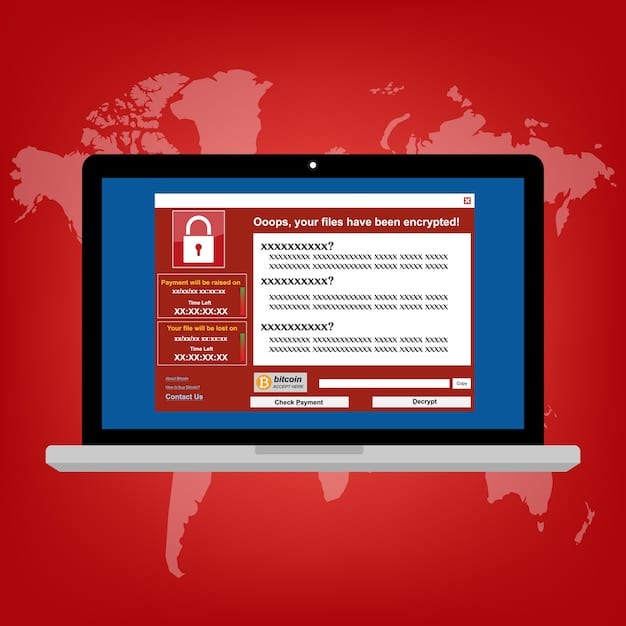Is Your Online Payment Secure? A 2025 US Guide to Fraud Prevention

In 2025, ensuring your online payment method is secure against fraud requires understanding advanced security measures like two-factor authentication, staying informed about the latest scams, and regularly monitoring your financial accounts.
Are you confident that your online payment methods are secure in 2025? With cyber threats constantly evolving, it’s crucial to understand the latest risks and how to protect yourself. This guide will help you navigate the world of online transactions and keep your money safe.
Understanding the Evolving Landscape of Online Payment Fraud
Online payment fraud is a constantly shifting threat, and understanding its current form is the first step to protecting yourself. As technology advances, so do the methods employed by cybercriminals.
In 2025, we can expect to see even more sophisticated phishing schemes, malware attacks targeting mobile payment apps, and synthetic identity fraud, where criminals create fake identities to open accounts and make fraudulent purchases. Being aware of these trends is vital for staying one step ahead.
Common Types of Online Payment Fraud in 2025
Several types of online payment fraud are prevalent in 2025. It helps to be aware of a few of them so that you know the warning signs.
- Phishing: Scammers use deceptive emails or websites to trick you into divulging your financial information.
- Malware Attacks: Malicious software steals your payment information directly from your device.
- Account Takeover: Criminals gain access to your accounts using stolen usernames and passwords.
- Card Skimming: Illegally obtaining your credit card information from compromised payment terminals.
The Role of Technology in Fraud Prevention
Technology plays a crucial role in both enabling and preventing online payment fraud. While criminals exploit vulnerabilities, advancements like blockchain and AI are also being used to enhance security. For instance, we may see a lot of biometrics, in the form of fingerprint or facial recognition, being used at more online checkouts.
Staying informed about these technological developments is essential for understanding the future of online payment security. As we adopt new technologies, so must our security precautions change.
In conclusion, being aware of the current landscape of online payment fraud, including common types of scams and the role of technology, is crucial for safeguarding your financial information.
Assessing the Security of Different Payment Methods
Not all online payment methods are created equal when it comes to security. Understanding the strengths and weaknesses of each option can help you make informed decisions about how to pay online safely.
Different payment methods offer varying levels of protection against fraud. Credit cards, for instance, often come with fraud protection policies and dispute resolution processes. Payment platforms like PayPal offer additional layers of security through encryption and transaction monitoring.

Credit Cards
Credit cards are a popular choice for online purchases, and for good reason. They come with several built-in security features.
- Fraud Protection: Most credit card companies offer fraud protection, limiting your liability for unauthorized charges.
- Dispute Resolution: You can dispute fraudulent transactions and potentially get your money back.
- EMV Chip Technology: Chip-enabled cards are more difficult for criminals to counterfeit.
Payment Platforms
Payment platforms like PayPal, Apple Pay, and Google Pay offer an additional layer of security by acting as intermediaries between you and the merchant.
- Encryption: Your payment information is encrypted, protecting it from hackers.
- Transaction Monitoring: Payment platforms monitor transactions for suspicious activity.
- Two-Factor Authentication: Many platforms offer two-factor authentication to add an extra layer of security to your account.
Choosing the right payment method involves assessing your risk tolerance, the types of purchases you typically make, and the security features offered by each option. By weighing these factors, you can select the payment methods that best protect your financial information.
Implementing Two-Factor Authentication (2FA) for Added Security
In an era of increasingly sophisticated cyber threats, simple passwords are no longer enough to protect your online accounts. Two-Factor Authentication (2FA) adds an extra layer of security, making it significantly more difficult for criminals to access your financial information.
2FA requires you to provide two different types of authentication factors to verify your identity when logging in. This means that even if a hacker manages to steal your password, they will still need a second factor to access your account.
How 2FA Works
2FA works by requiring you to provide two different types of authentication factors.
- Something you know (your password)
- Something you have (a code sent to your phone or generated by an authenticator app)
- Something you are (biometric data like a fingerprint or facial recognition)
Setting Up 2FA on Your Accounts
Enabling 2FA on your online accounts is a straightforward process that can significantly enhance your security.
- Check Account Settings: Look for the security settings in your account and enable 2FA.
- Choose an Authentication Method: Select how you want to receive your verification codes (e.g., SMS, authenticator app).
- Follow the Instructions: Follow the prompts to complete the setup process.
2FA is an essential security measure for protecting your online accounts from unauthorized access. By implementing this extra layer of protection, you can significantly reduce your risk of falling victim to fraud.
Recognizing and Avoiding Phishing Scams
Phishing scams are a prevalent threat in the online world, seeking to trick you into divulging your personal and financial information. Learning to recognize and avoid these scams is essential for protecting yourself from fraud.
Phishing scams typically involve deceptive emails, messages, or websites that mimic legitimate organizations, such as banks, retailers, or government agencies. These scams often contain urgent or threatening language to pressure you into acting without thinking.
Identifying Common Phishing Tactics
Being able to spot the common tactics used in phishing scams is key to avoiding them.
- Suspicious links: Scammers often include links that lead to fake websites designed to steal your information.
- Urgent requests: Phishing emails often create a sense of urgency, pressuring you to act quickly before you have time to think.
- Grammar and spelling errors: Phishing emails often contain typos and grammatical errors that legitimate organizations would not make.

Staying Safe from Phishing Attacks
Protecting yourself from phishing attacks requires vigilance and a healthy dose of skepticism.
- Verify the Sender: Always check the sender’s email address and verify that it matches the organization they claim to represent.
- Never Click on Suspicious Links: If you receive an email with a link, hover over the link to see where it leads before clicking on it.
- Report Phishing Attempts: If you receive a phishing email, report it to the organization being impersonated and to your email provider.
By staying vigilant and following these tips, you can significantly reduce your risk of falling victim to phishing scams and protect your personal and financial information.
Keeping Your Software and Apps Up to Date
In the fight against online payment fraud, one of the simplest yet most effective measures you can take is to keep your software and apps up to date. Software updates often include critical security patches that address vulnerabilities exploited by cybercriminals.
Outdated software and apps are like unlocked doors for hackers. They leave your system exposed to known vulnerabilities that can be used to steal your payment information or install malware.
The Importance of Security Patches
Security patches are updates that address specific vulnerabilities in software and apps. These patches are designed to fix flaws that could be exploited by hackers to gain unauthorized access to your system.
Software vendors regularly release security patches to address newly discovered vulnerabilities. By installing these patches promptly, you can close the door on potential attacks and protect your system from harm.
Enabling Automatic Updates
To ensure that your software and apps are always up to date, enable automatic updates whenever possible. This way, you won’t have to manually check for and install updates.
- Operating System: Enable automatic updates for your computer’s operating system (e.g., Windows, macOS, iOS, Android).
- Web Browser: Ensure that your web browser (e.g., Chrome, Firefox, Safari) is set to update automatically.
- Payment Apps: Enable automatic updates for any payment apps you use on your mobile device.
Keeping your software and apps up to date is a simple yet effective way to protect yourself. By enabling automatic updates, you can ensure that your system is always protected against the latest threats.
Monitoring Your Accounts and Transactions Regularly
Even with the best security measures in place, it’s important to monitor your accounts and transactions regularly for any signs of fraud. Early detection can help limit the damage and prevent further losses.
Regularly reviewing your account statements and transaction history can help you identify unauthorized charges, suspicious activity, or other signs of fraud. It’s like having a watchful eye over your financial health.
Catching Suspicious Activity
When monitoring your accounts and transactions, be on the lookout for these common signs of fraud:
- Unauthorized Charges: Any charges that you don’t recognize or didn’t authorize.
- Small Test Transactions: Small, often random, charges that are used to test whether your card is active.
- Unfamiliar Merchants: Transactions from merchants you’ve never heard of or don’t typically do business with.
Taking Action When You Spot Fraudulent Activity
If you spot any suspicious activity on your accounts, take immediate action to limit the damage:
- Contact Your Bank or Credit Card Company: Report the fraudulent activity immediately.
- Change Your Passwords: Update the passwords for any affected accounts.
- Monitor Your Credit Report: Check your credit report for any signs of identity theft.
Regularly monitoring your accounts and transactions is essential for protecting yourself from fraud. By staying vigilant and taking action promptly when you spot suspicious activity, you can minimize your losses and protect your financial well-being.
| Key Point | Brief Description |
|---|---|
| 🔒 2FA Implementation | Enables an extra layer of security for online accounts to prevent unauthorized access. |
| 🛡️ Regular Monitoring | Involves checking account statements and transaction history regularly for fraudulent activity. |
| ⚠️ Phishing Awareness | Understanding how to identify phishing scams and tactics to avoid being a victim. |
| 🔄 Software Updates | Ensuring that all software and apps are updated regularly for critical security patches. |
Frequently Asked Questions
▼
The most common types include phishing scams, malware attacks targeting payment apps, account takeover fraud, and synthetic identity fraud where criminals create fake identities to open accounts.
▼
2FA adds an extra layer of security by requiring a second authentication factor, such as a code sent to your mobile device, making it more difficult for hackers to access your accounts.
▼
If you suspect a phishing attempt, do not click on any links or provide any personal information. Report the attempt to the organization being impersonated and your email provider.
▼
Keeping your software and apps updated ensures that you have the latest security patches, which protect against known vulnerabilities that cybercriminals can exploit to access your payment information.
▼
You should monitor your online payment accounts regularly, preferably daily or at least weekly, to catch any suspicious activity quickly. Check for unauthorized charges and unfamiliar merchants.
Conclusion
Protecting your online payment methods in 2025 requires a proactive approach, including understanding the latest fraud trends, implementing security measures like 2FA, staying informed about phishing scams, keeping your software up to date, and monitoring your accounts regularly. By taking these steps, you can significantly reduce your risk of falling victim to online payment fraud.





